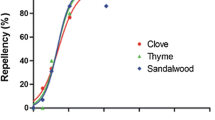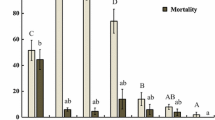Abstract
Tineola bisselliella is a common pest on natural fabrics of economic importance. Two commercially available repellents for use against adult webbing clothes moths were tested for their efficacy in dual- and no-choice bioassays. Oil of cloves and citral in combination, as well as citronellol scented with oil of lavender showed promising repellent effects for 4 weeks when applied in small compartments of a wardrobe. Although the repellent efficacy was not 100% under the conditions tested, the usage of essential oils in combination with other infestation prevention techniques is discussed.
Zusammenfassung
Die KleidermotteTineola bisselliella Hum. ist einer der wirtschaftlich bedeutenden tierischen Wollzerstörer. Auch Pelze, Felle, Polsterhaare und Federn werden von dem weit verbreiteten Kleinschmetterling aus der Familie der Tineidae befallen. In der Praxis gilt es vor allem Kleidungsstücke, die z. B. saisonbedingt für längere Zeit ungenutzt in einem Kleiderschrank aufbewahrt werden, vor dem Befall durch die Kleidermotte zu schützen. Hierfür stehen dem Verbraucher neben den konventionellen Bekämpfungsmitteln mit den Wirkstoffen Kampfer, Naphthalin und Paradichlorbenzol sowie pyrethrum- und pyrethroidhaltige Mittel auch Präparate zur Verfügung, die auf die repellierende Wirkung von ätherischen Ölen zurückgreifen. Die abstoßende Wirkung von Nelkenöl in Kombination mit Citral und von Citronellol parfümiert mit Lavendelöl auf die Falter der Kleidermotte wurde auf vergleichbare Eigenschaften untersucht. In Wahlversuchen wurden deutliche Repellent-Wirkungen der Mottenschutz-Präparate sichtbar. Die Präparate zeigten gute Wirkungen, wenn sie zum Schutz gegen den Zuflug von Kleidermotten an wollhaltigen Stoffen in kleinen Kompartimenten eines Kleiderschrankes ausgelegt waren. Auch in Zwangsversuchen hatte dieser Befund zum Teil Bestand. Bei längeren Versuchszeiten wurden allerdings verstärkt Fraßschäden durch Larven an den Wollstoffen festgestellt. Dies ist darauf zurückzuführen, daß Mottenweibchen nicht mehr in dem Maße repelliert wurden und ihre Eier an den Stoffen ablegten.
Similar content being viewed by others
References
Back, E. A., 1940: Clothes moths. Leaflet No. 154 U.S. Department of Agriculture.
Becker, G., 1983: Materialschädlinge. In: Leitfaden der Schädlingsbekämpfung, Band IV: Vorrats- und Materialschädlinge. Ed. byK. Heinze, Wiss. Verlagsges. Stuttgart, S. 269–330.
Bestmann, H. J.;Pietschmann, M.;Gunawardena, N. E.;Vostrowski, O., 1993: Pflanzliche Insektizide X: Olfaktometerversuche zur Repellentwirkung der Samen vonCrotalaria ochroleuca und Untersuchungen des Abdampfverhaltens der Inhaltsstoffe mittels closed-loop stripping. J. Appl. Entomol. 115, 425–431.
Borchert, M.; Prozell, S., 1989: Untersuchungen über die insektizide Wirkung von ätherischen Ölen. Dipl. Arb. Inst. für Zool., Freie Univ. Berlin.
Brokerhof, A. W.;Morton, R.;Banks, H. J., 1993: Time-mortality relationships for different species and developmental stages of clothes moths (Lepidoptera: Tineidae) exposed to cold. J. Stored Prod. Res.29, 227–282.
Budavari, S.;O'Neil, M. J., Smith, A.;Heckelman, P. E., 1989: The Merck Index-An Encyclopedia of Chemicals, Drugs, and Biologicals, Merck & Co., Inc. Rahway, N. J., USA.
Detmers, H. B.;Wohlgemuth, R.;Schneider, E., 1992: Über die Wirkung von Steinkleekraut und Patschuliölgranulat auf die KleidermotteTineola bisselliella Hum. (Lepidoptera: Tineidae). Anz. Schädlingsk., Pflanzenschutz, Umweltschutz65, 81–88.
Flint, W. P.; McCauley, W. E., 1937: Fabric insects. University of Illinois, College of Agric. Exp. Stat. Circ. 473.
Hammers, J., 1987: Neue Beiträge zum Abbau von Wolle durch Motten- und Käferlarven. Schriftenr. d. Deutsch. Wollforsch. Inst.100, 1–92.
Johnson, J. P.; Turner, N., 1960: Insects in houses. Connecticut Agric. Exp. Stat. Circ. 213.
Jones, O. T., 1993: Future directions in urban entomology —pheromones. Proceedings 1st Conf. Insect Pests Urban Environ., Cambridge, pp. 441–448.
Kemper, H., 1935: Die Pelz- und Textilschädlinge und ihre Bekämpfung. Hygienische Zoologie, Monographien zur Biologie und Bekämpfung der Gesundheits- und Wohnungsschädlinge: Band 7.
Lienard, V.;Seck, D.;Lognay, G.;Gaspar, C.;Sseverin, M., 1993: Biological activity ofCassia occidentalis L. againstCallosobruchus maculatus (F.) (Coleoptera: Bruchidae). J. Stored Prod. Res.29, 331–318.
Pierce, S.;Schmidt, G. H.; 1993: Wirkung von ätherischem Öl ausAcorus calamus (L.)-Rhizomen und Beta-Asaron auf den großen KornbohrerProstephanus truncatus (Horn) (Coleoptera: Bostrichidae). Anz. Schädlingskde., Pflanzenschutz, Umweltschutz66, 89–96.
Qi, Y. T.;Burkholder, W. E., 1981: Protection of stored wheat from the granary weevil by vegetable oils. J. Econ. Entomol.74, 502–505.
Sarac, A.;Tunc, I., 1995: Toxicity of essential oil vapours to stored-product insects. Zeit. Pflanzenkrankheiten Pflanzenschutz 102, 69–74.
Scheffler, I.;Dombrowski, M.; 1993: Behavioural responses ofBlattella germanica L. (Orthopt., Blattellidae) induced by repellent plant extracts. J. Appl. Entomol.115, 499–505.
Schilcher, H., 1984: Ätherische Öle Wirkungen und Nebenwirkungen. Deut. Apotheker Zeit.29.
Sellenschlo, U., 1990: Kleidermotten in Backwaren. Der Praktische Schädlingsbekämpfer90, 34–35.
Singh, V. N.;Pandey, N. D.;Singh, Y. P., 1993: Efficacy of vegetable oils for the control ofCallosobruchus chinensis (L.) infesting gram and their subsequent effect in germination. Bull. Grain Tech.31, 13–16.
Traynier, R. M. M.;Schumacher, R. K.;Lau, D. M., 1994: Oviposition site selection byTineola bisselliella, Tinea spp. (Lepidoptera: Tineidae) andAnthrenus flavipes (Coleoptera: Dermestidae). J. Stored Prod. Res.30, 321–329.
Trematerra, P.;Fontana, F. 1996: Monitoring of webbing clothes moth,Tineola bisselliella (Hummel), by sex pheromone. Anz. Schädlingskde., Pflanzenschutz, Umweltschutz69, 119–121.
Turner, N.; Walden, B. H., 1937: Some common household insects and their control. Connecticut Agric. Exp. Stat. Bull. 400.
Weaver, D. K.;Dunkel, F. V.;Ntezubanza, L.;Jackson, L. L.;Stock, D. T., 1991: The efficacy of linalool, a major component of freshly-milled Ocimum canum (SIMS) (laminaceae), for protection against postharvest damage by certain stored product Coleoptera. J. Stored Prod. Res.27, 213–220.
Wudtke, A.; Reichmuth, Ch., 1994: Control of the common clothes mothTineola bisselliella (Hummel) (Lepidoptera: Tineidae) and other museum pests with nitrogen. In:Highley, E; Wright, J. E.; Bankk, H. J.; Champ, B. R. (eds.), Stored Prod. Prot. Proceed. 6th Intern. Work. Conf. Stored-Prod. Prot., Canberra Vol.1, 251–254.
Author information
Authors and Affiliations
Additional information
This article reports the results of research only. Mention of a proprietary product or pesticide does not constitute an endorsement or a recommendation for its use by the Federal Biological Research Centre for Agriculture and Forestry or by the USDA-ARS.
Rights and permissions
About this article
Cite this article
Plarre, R., Pöschko, M., Prozell, S. et al. Effects of oil of cloves and citronellol, two commercially available repellents, against the webbing clothes mothTineola bisselliella Hum. (Lepidoptera: Tineidae). Anz. Schadlingskde., Pflanzenschutz, Umweltschutz 70, 45–50 (1997). https://doi.org/10.1007/BF01996920
Issue Date:
DOI: https://doi.org/10.1007/BF01996920




